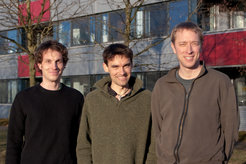Building a bridge between string theory and solid state physics
Junior scientists from the Albert Einstein Institute receive publication prize.
The prize, with a value of 500 Euros, for the best publication by junior scientists in the Journal of Statistical Mechanics Theory and Experiment (JSTAT) for 2008 goes to three young scientists from the Max Planck Institute for Gravitational Physics (Albert Einstein Institute, AEI). The prize-winning article explores remarkable properties of the string theory which thus far were reserved for models related to solid state physics and magnetism. According to the jury: “The work takes several important steps in the development of this theory. [...]“

The Journal of Statistical Mechanics bestows the publication prize yearly. A precondition for a successful application is not only an excellent scientific article, but also that the doctorates of all participating authors were awarded within the last five years. Dr. Niklas Beisert, Leader of a Max Planck Research Group at the AEI, and his doctoral students Till Bargheer and Florian Loebbert are very pleased about the honour and the recognition accorded their research work.
In search of a unified theory: Duality of quantum field and gravitational theory
In the physical description of nature, four fundamental forces are distinguished: the electromagnetic force, the strong and weak nuclear force, and gravity. The first three of these forces are described within the framework of theoretical physics through so-called quantum field theories; the gravitational force, on the other hand, through Einstein’s general theory of relativity. A possible amalgamation of these two classes of theories and thus the explanation of physical natural laws from a unified principle is one of the biggest unsolved problems of modern physics. For several years now, the so-called duality between quantum field and gravitational theories is the focus of research being conducted at numerous scientific institutes throughout the world. It is assumed that special quantum theories can be exactly reproduced on gravitation theories and/or string theories in a specific space-time configuration. This means that both theories in this special configuration describe exactly the same thing, therefore dual. This assumption has the enormous potential to contribute to the understanding of a possible unified theory.
In the Max Planck Research Group “Duality and Integrable Structures” at the Albert Einstein Institute to which the three honoured researchers belong, the mathematical structures of these dual theories are being studied. The underlying models are based on generalisations of known methods from solid state physics. A very helpful characteristic of the theories involved in duality and which is being closely examined is so-called integrability. Integrability means that in the theories, in addition to energy and impulse, there are still many other parameters (charges) that remain intact during physical processes. The determination of the energy spectrum and physical processes are extremely simplified through these charges and in many cases concrete calculations made possible in the first place.
The prize-winning research focuses on this charge conservation. It has been shown how retained charges are recursively generated, i.e. how complex charges can be generated from simple charges during which special characteristics are retained. This construction proves in particular that the integrable structures, which have been successfully employed in this area for several years already, can be defined with mathematical consistency.
Till Bargheer (b. 1980) studied physics at the University of Kiel. After a course of studies at Princeton University, he took up his doctoral studies in 2008 under the supervision of Dr. Niklas Beisert at the AEI.
Dr. Niklas Beisert (b. 1977), after studying physics at the Technical University of Munich and doing his doctorate at the Albert Einstein Institute (2004), was initially lecturer and then assistant professor at Princeton University. Since August 2006, he has led the Max Planck Research Group “Duality and Integrable Structures” at the AEI.
In 2005 he was awarded the Otto Hahn Medal. The Otto Hahn Medal is bestowed by the Max Planck Society annually on young scientists for outstanding scientific achievements. In 2007 he was honoured with the Gribov Medal of the European Physical Society for his contribution to better understanding a four-dimensional quantum field theory.
Florian Loebbert (b. 1983) studied physics at the University of Cologne and University of Cambridge and has been working on his doctorate at the AEI since 2007 under the supervision of Dr. Niklas Beisert.










